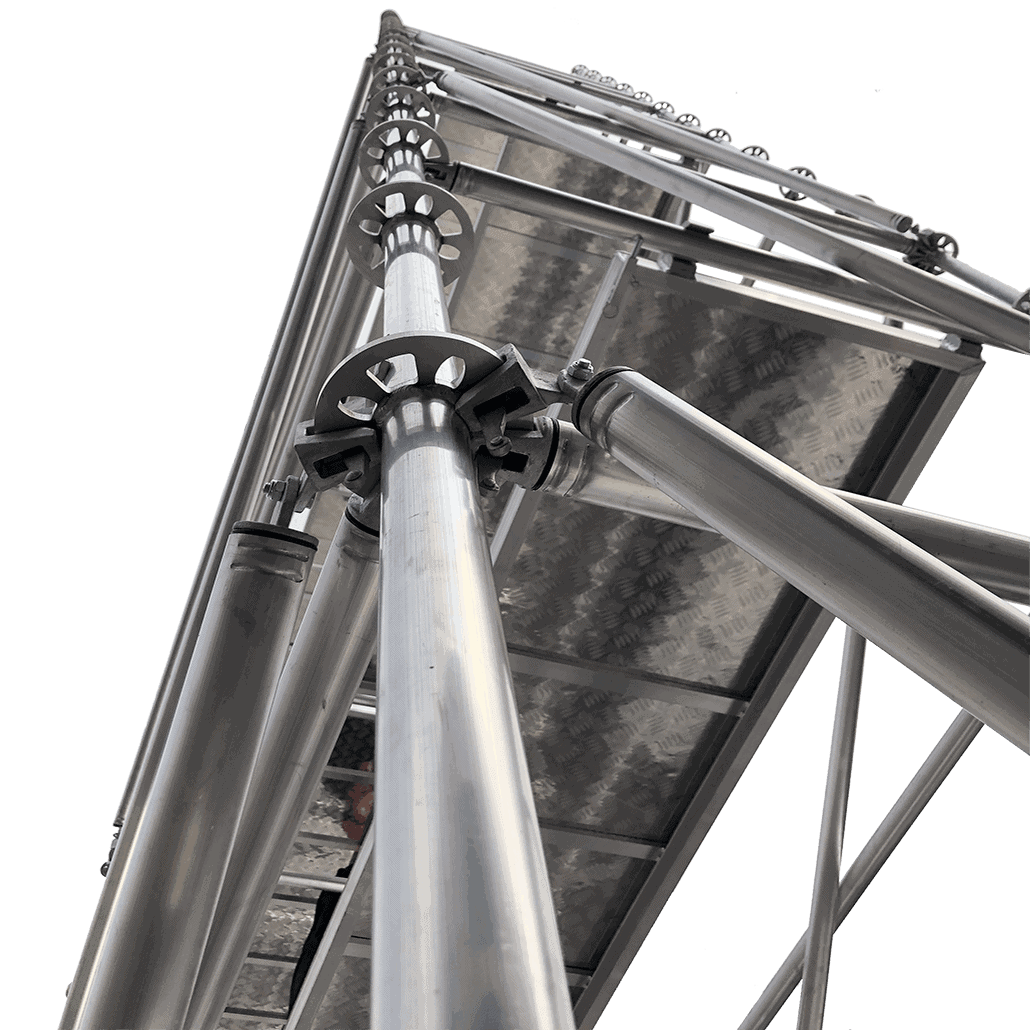 Aluminiumgerüste bieten zwar mehrere Vorteile, wie z. B. geringes Gewicht, Korrosionsbeständigkeit und einfache Montage, bringen aber auch eine Reihe von Nachteilen mit sich, die ihre Eignung für bestimmte Projekte beeinträchtigen können. Hier sind die Hauptnachteile von Aluminiumgerüsten:
Aluminiumgerüste bieten zwar mehrere Vorteile, wie z. B. geringes Gewicht, Korrosionsbeständigkeit und einfache Montage, bringen aber auch eine Reihe von Nachteilen mit sich, die ihre Eignung für bestimmte Projekte beeinträchtigen können. Hier sind die Hauptnachteile von Aluminiumgerüsten:- Höhere Anschaffungskosten: Aluminiumgerüste sind im Allgemeinen teurer als Stahlgerüste. Diese höheren Vorlaufkosten können ein erheblicher Faktor für Projekte mit knappen Budgets oder solchen sein, die umfangreiche Gerüste erfordern.
- Geringere Tragfähigkeit: Obwohl Aluminium im Verhältnis zu seinem Gewicht stark ist, hält es nicht so schweren Lasten stand wie Stahlgerüste. Diese Einschränkung macht es weniger geeignet für schwere Bauarbeiten und Projekte, bei denen schwere Geräte oder Materialien angehoben werden müssen.
- Anfälligkeit für Schäden: Aluminium ist weicher als Stahl und daher anfälliger für Dellen und Beschädigungen, wenn es nicht sorgfältig behandelt wird. Dies kann die langfristige strukturelle Integrität des Gerüsts beeinträchtigen, wenn es häufig bewegt oder rauen Bedingungen ausgesetzt wird..
- Begrenzte Höhe und Reichweite: Aluminiumgerüste können in der Regel nicht die gleichen Höhen erreichen wie Stahlgerüste, was bei Projekten, die einen Zugang in großer Höhe erfordern, wie z. B. Hochhäuser oder Brücken, ein Nachteil sein kann..
- Eingeschränkte Verfügbarkeit: In einigen Regionen sind Aluminiumgerüste möglicherweise nicht so leicht verfügbar wie Stahlgerüste. Dies kann logistische Herausforderungen mit sich bringen und möglicherweise die Kosten erhöhen, wenn Materialien von weit entfernten Lieferanten bezogen werden müssen..
- Reparaturbeschränkungen: Wenn sich ein Aluminiumgerüst verformt, lässt es sich möglicherweise nicht so leicht reparieren wie ein Stahlgerüst, was sich im Laufe der Zeit auf seine Langlebigkeit und Kosteneffizienz auswirken kann..
Inhaltsverzeichnis
Aluminiumgerüste haben mehrere Nachteile, wie zum Beispiel reduzierte Kraft im Vergleich zu Stahl, wodurch es weniger geeignet ist für Schwerlastprojekte. Bei Überlastung kann es außerdem verbogen oder beschädigt werden. Darüber hinaus können Aluminiumgerüste teurer sein, was bei großen oder langfristigen Projekten möglicherweise nicht wirtschaftlich ist.
Nachdem Sie nun die grundlegenden Nachteile von Aluminiumgerüsten kennen, wollen wir uns mit den spezifischen Aspekten ihrer Haltbarkeit, Kosten und Festigkeit befassen, die Ihre Entscheidung für Bauprojekte beeinflussen können.
Warum sind Aluminiumgerüste weniger haltbar als Stahlgerüste?
Besorgt über die Haltbarkeit? Aluminiumgerüste sind weniger haltbar als Stahlgerüste, da sie eine geringere Zugfestigkeit aufweisen und daher bei schwerer Belastung anfälliger für Beschädigungen oder Verbiegungen sind.
Aluminiumgerüste sind weniger haltbar als Stahlgerüste aufgrund ihrer geringere Zugfestigkeit. Obwohl Aluminium leichter und einfacher zu transportieren ist, kann es sich bei schweren Lasten oder hoher Beanspruchung verbiegen oder verziehen, was seine Verwendung in anspruchsvolle Bauvorhaben.
Aluminiumgerüste sind im Allgemeinen weniger haltbar als Stahlgerüst wegen seiner untere Zugfestigkeit. Stahl kann schwerere Lasten tragen und mehr Belastungen standhalten, wodurch er sich besser für größere oder komplexere Bauprojekte eignet. Aluminium ist zwar leicht und einfach zu transportieren, kann aber biegen, Ketteoder werden beschädigt unter schweren Lasten, insbesondere bei Anwendungen mit hoher Beanspruchung. Dies macht Aluminiumgerüste weniger ideal für Projekte, die eine erhebliche Tragfähigkeit erfordern. Darüber hinaus kann Aluminium anfälliger für Schäden durch Stöße oder grobe Handhabung auf Baustellen sein, was seine Haltbarkeit im Vergleich zu Stahl weiter verringert.
Warum ist ein Aluminiumgerüst teurer als ein Stahlgerüst?
Budgetbedenken? Aufgrund der höheren Produktionskosten, des geringen Gewichts und des höheren Komforts sind Aluminiumgerüste in der Regel teurer als Stahlgerüste, weshalb sie bei größeren Projekten weniger kosteneffizient sind.
Aluminiumgerüste sind oft teurer als Stahlgerüste, da Aluminium ein leichtes, korrosionsbeständiges Material ist und die Produktionskosten höher sind. Obwohl es für den Transport und die Montage bequem ist, ist der höhere Preis bei langfristigen oder groß angelegten Projekten, die eine hohe Haltbarkeit erfordern, möglicherweise nicht gerechtfertigt.
Aluminiumgerüst ist aus mehreren Gründen teurer als Stahl. Der Produktionskosten von Aluminium sind höher aufgrund seiner leichte Natur Und korrosionsbeständig Eigenschaften, die es zu einem wünschenswerten Material für Projekte machen, bei denen Mobilität und einfacher Transport unerlässlich sind. Dieser zusätzliche Komfort hat jedoch seinen Preis, und der Preis für Aluminiumgerüste ist möglicherweise nicht gerechtfertigt für groß angelegt oder langfristig Projekte, bei denen Stärke und Haltbarkeit wichtiger sind. Stahlgerüste sind zwar schwerer, aber oft die kostengünstig Wahl für Projekte, die eine hohe Tragfähigkeit und langfristige Stabilität erfordern.
Lohnt sich ein Aluminiumgerüst?
Überlegen Sie, ob sich ein Aluminiumgerüst lohnt? Aluminiumgerüste lohnen sich für Projekte, bei denen Mobilität und schnelle Montage erforderlich sind. Aufgrund ihrer höheren Kosten und geringeren Festigkeit sind sie für Schwerlastkonstruktionen jedoch möglicherweise nicht ideal.
Aluminiumgerüste lohnen sich für leicht oder temporäre Projekte wo Tragbarkeit und Benutzerfreundlichkeit im Vordergrund stehen. Aufgrund seines höheren Preises und seiner geringeren Festigkeit im Vergleich zu Stahl ist es jedoch weniger geeignet für Schwerlast oder Langfristige Konstruktion Projekte, die maximale Stabilität erfordern.
Aluminiumgerüst kann je nach Art des Projekts eine Investition wert sein. Es wird sehr geschätzt für seine leicht, tragbar Natur und einfache Montageund ist somit ideal für Temporäre Bauten, Innenprojekteoder Bauarbeiten, die häufiges Bewegen und Umstellen des Gerüsts erfordern. Für Schwerlastprojekte oder für den langfristigen Einsatz im Freien, wo höhere Belastbarkeit Und Haltbarkeit sind unerlässlich, dann ist ein Aluminiumgerüst möglicherweise nicht die beste Option. Die höheren Kosten im Vergleich zu Stahl sind möglicherweise nicht gerechtfertigt, wenn das Projekt erhebliche Festigkeit oder eine langfristige Nutzung erfordert. In diesen Fällen ist ein Stahlgerüst in der Regel die bessere und kostengünstigere Wahl.
Ist ein Aluminiumgerüst für den Schwerlastbau sicher?
Besorgt über die Sicherheit? Aufgrund der geringeren Tragfähigkeit und der Anfälligkeit für Schäden bei starker Beanspruchung sind Aluminiumgerüste für Schwerlastkonstruktionen möglicherweise nicht die sicherste Option.
Aluminiumgerüste eignen sich weniger für robuste Konstruktion weil es nicht so viel Gewicht tragen kann wie Stahl. Während es für kleinere Projekte gut geeignet ist, neigt Aluminium bei schweren Lasten eher dazu, sich zu verbiegen oder zusammenzubrechen, was es für anspruchsvolle Bauumgebungen weniger sicher macht.
Während Aluminiumgerüste nützlich sind für leichte Beanspruchung oder temporäre Projektewird es im Allgemeinen nicht empfohlen für robuste Konstruktion. Der geringere Tragfähigkeit aus Aluminium bedeutet, dass es nicht die gleichen schweren Lasten wie Stahlgerüste sicher tragen kann, was es anfälliger für Biegen, zusammenbrechend, oder versagen unter Spannung. Für Projekte, die eine erhebliche Gewichtsbelastung erfordern, wie Hochhausbau oder für industrielle Arbeiten ist ein Stahlgerüst die sicherere Option. Obwohl ein Aluminiumgerüst leichter zu bewegen und aufzubauen ist, ist es aufgrund seiner begrenzten Festigkeit weniger geeignet für anspruchsvolle Bauumgebungen, in denen Sicherheit oberste Priorität hat.
Können Aluminiumgerüste bei extremen Wetterbedingungen eingesetzt werden?
Arbeiten bei rauem Wetter? Aluminiumgerüste sind zwar korrosionsbeständig, eignen sich jedoch nicht so gut für extreme Wetterbedingungen, da sie bei hohen Temperaturen dazu neigen, sich auszudehnen oder zusammenzuziehen, was ihre Stabilität beeinträchtigt.
Aluminiumgerüste eignen sich nicht für extreme Wetterbedingungen. Obwohl Aluminium korrosionsbeständig ist, dehnt es sich bei hohen oder niedrigen Temperaturen stärker aus und zieht sich stärker zusammen als Stahl, was in rauen Klimazonen zu Instabilität oder strukturellen Problemen führen kann.
Aluminiumgerüst ist möglicherweise nicht die beste Option für Projekte, die in extreme WetterbedingungenEs hat zwar den Vorteil, korrosionsbeständigist es anfälliger für Erweiterung Und Kontraktion wenn sie großen Temperaturschwankungen ausgesetzt sind. Dies kann dazu führen Instabilität und die strukturelle Integrität des Gerüsts beeinträchtigen. In Umgebungen mit hohen Temperaturen kann sich Aluminium ausdehnen, während es sich bei extremer Kälte zusammenziehen kann, was zu möglichen Lücken oder geschwächten Verbindungen führen kann. Stahlgerüste hingegen sind weniger von Temperaturschwankungen betroffen und sind oft die bessere Wahl für Projekte in Gebieten mit rauen Wetterbedingungen.
Welche weiteren Einschränkungen gibt es bei Aluminiumgerüsten?
Möchten Sie andere Einschränkungen verstehen? Aluminiumgerüste sind zwar praktisch, weisen jedoch Einschränkungen hinsichtlich der Tragfähigkeit, Stoßfestigkeit und Lebensdauer auf, was sie für langfristige oder hochintensive Projekte weniger effektiv macht.
Aluminiumgerüste haben auch andere Nachteile, wie zum Beispiel geringere Schlagfestigkeit, was bedeutet, dass es wahrscheinlicher durch versehentliche Schläge beschädigt wird. Darüber hinaus ist es Lebensdauer ist kürzer als Stahl, insbesondere bei hochintensiven Projekten, die eine langfristige Haltbarkeit erfordern.
Abgesehen von der geringeren Festigkeit und den höheren Kosten, Aluminiumgerüst hat andere Einschränkungen. Eine davon ist die geringere Schlagfestigkeit, was bedeutet, dass es wahrscheinlicher ist, dass es durch versehentliche Stöße oder Schläge auf Baustellen beschädigt wird, was seine Stabilität beeinträchtigen kann. Darüber hinaus kann ein Aluminiumgerüst eine kürzere Lebensdauer im Vergleich zu Stahl bei der Verwendung in hochintensiven Projekten, die eine langfristige Haltbarkeit erfordern. Obwohl es leicht zu montieren und zu bewegen ist, sind Aluminiumgerüste aufgrund dieser Einschränkungen weniger geeignet für komplexe oder anspruchsvolle Bauaufgaben, die eine hohe Festigkeit und langfristige Zuverlässigkeit erfordern.
Abschluss
Zusammenfassend lässt sich sagen, dass Aluminiumgerüste mehrere Nachteile haben, darunter geringere Festigkeit, höhere Kosten und geringere Haltbarkeit im Vergleich zu Stahl. Während sie ideal für leichte, temporäre Projekte sind, sind Aluminiumgerüste möglicherweise nicht für Schwerlastkonstruktionen oder extreme Wetterbedingungen geeignet.
